-
TPS6102x 96% Efficient Synchronous Boost Converter
- 1 Features
- 2 Applications
- 3 Description
- 4 Typical Schematic
- 5 Revision History
- 6 Device Comparison Table
- 7 Pin Configuration and Functions
- 8 Specifications
- 9 Parameter Measurement Information
- 10Detailed Description
- 11Application and Implementation
- 12Power Supply Recommendations
- 13Layout
- 14Device and Documentation Support
- 15Mechanical, Packaging, and Orderable Information
- IMPORTANT NOTICE
Package Options
Mechanical Data (Package|Pins)
- DRC|10
Thermal pad, mechanical data (Package|Pins)
- DRC|10
Orderable Information
TPS6102x 96% Efficient Synchronous Boost Converter
1 Features
- 96% Efficient Synchronous Boost Converter
- Output Voltage Remains Regulated When Input Voltage Exceeds Nominal Output Voltage
- Device Quiescent Current: 25 µA (Typ)
- Input Voltage Range: 0.9 V to 6.5 V
- Fixed and Adjustable Output Voltage Options Up to 5.5 V
- Power Save Mode for Improved Efficiency at Low Output Power
- Low Battery Comparator
- Low EMI-Converter (Integrated Anti-ringing Switch)
- Load Disconnect During Shutdown
- Overtemperature Protection
- Small 3-mm × 3-mm VSON-10 Package
2 Applications
- All One-Cell, Two-Cell, and Three-Cell Alkaline, NiCd or NiMH, or One-Cell Li-Ion or Li-Polymer Battery-Powered Products
- Portable Audio Players
- PDAs
- Cellular Phones
- Personal Medical Products
- Camera White LED Flash Lights
3 Description
The TPS6102x family of devices provide a power supply solution for products powered by either a one-cell, two-cell, or three-cell alkaline, NiCd or NiMH, or one-cell Li-Ion or Li-polymer battery. Output currents can go as high as 200 mA while using a single-cell alkaline battery, and discharge it down to 0.9 V. The device can also be used for generating 5 V at 500 mA from a 3.3-V rail or a Li-Ion battery. The boost converter is based on a fixed-frequency, pulse width modulation (PWM) controller using a synchronous rectifier to obtain maximum efficiency. At low load currents the converter enters the power save mode to maintain a high efficiency over a wide-load current range. The Power Save mode can be disabled, forcing the converter to operate at a fixed switching frequency. The maximum peak current in the boost switch is limited to a value of 800 mA, 1500 mA, or 1800 mA depending on the version of the device.
The TPS6102x devices keep the output voltage regulated even when the input voltage exceeds the nominal output voltage. The output voltage can be programmed by an external resistor divider, or is fixed internally on the chip. The converter can be disabled to minimize battery drain. During shutdown, the load is completely disconnected from the battery. A low-EMI mode is implemented to reduce ringing and, in effect, lower radiated electromagnetic energy when the converter enters the discontinuous conduction mode. The device is packaged in a 10-pin VSON PowerPAD™ package measuring 3 mm x 3 mm (DRC).
Device Information(1)
| PART NUMBER | PACKAGE | BODY SIZE (NOM) |
|---|---|---|
| TPS6102x | VSON (10) | 3.00 mm x 3.00 mm |
- For all available packages, see the orderable addendum at the end of the datasheet.
4 Typical Schematic

5 Revision History
Changes from F Revision (April 2012) to G Revision
- Added ESD Ratings table, Feature Description section, Device Functional Modes, Application and Implementation section, Power Supply Recommendations section, Layout section, Device and Documentation Support section, and Mechanical, Packaging, and Orderable Information sectionGo
6 Device Comparison Table
| TA | OUTPUT VOLTAGE DC-DC(1) | NOMINAL SWITCH CURRENT LIMIT | PART NUMBER(2) |
|---|---|---|---|
| –40°C to 85°C | Adjustable | 1500 mA | TPS61020DRC |
| Adjustable | 800 mA | TPS61028DRC | |
| Adjustable | 1800 mA | TPS61029DRC | |
| 3.0 V | 1500 mA | TPS61024DRC | |
| 3.3 V | 1500 mA | TPS61025DRC | |
| 5 V | 1800 mA | TPS61026DRC | |
| 5 V | 1500 mA | TPS61027DRC |
7 Pin Configuration and Functions
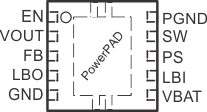
Pin Functions
| PIN | I/O | DESCRIPTION | |
|---|---|---|---|
| NAME | NO. | ||
| EN | 1 | I | Enable input. (1/VBAT enabled, 0/GND disabled) |
| FB | 3 | I | Voltage feedback of adjustable versions |
| GND | 5 | Control / logic ground | |
| LBI | 7 | I | Low battery comparator input (comparator enabled with EN), may not be left floating, should be connected to GND or VBAT if comparator is not used |
| LBO | 4 | O | Low battery comparator output (open drain) |
| PS | 8 | I | Enable/disable power save mode (1/VBAT disabled, 0/GND enabled) |
| SW | 9 | I | Boost and rectifying switch input |
| PGND | 10 | Power ground | |
| VBAT | 6 | I | Supply voltage |
| VOUT | 2 | O | Boost converter output |
| PowerPAD™ | — | — | Must be soldered to achieve appropriate power dissipation. Should be connected to PGND. |
8 Specifications
8.1 Absolute Maximum Ratings
over operating free-air temperature range (unless otherwise noted)(1)| MIN | MAX | UNIT | ||
|---|---|---|---|---|
| Input voltage on SW, VOUT, LBO, VBAT, PS, EN, FB, LBI | –0.3 | 7 | V | |
| TJ | Operating virtual junction temperature | –40 | 150 | °C |
| Tstg | Storage temperature | –65 | 150 | °C |
8.2 ESD Ratings
| VALUE | UNIT | |||
|---|---|---|---|---|
| V(ESD) | Electrostatic discharge | Human-body model (HBM), per ANSI/ESDA/JEDEC JS-001(1) | ±2000 | V |
| Charged-device model (CDM), per JEDEC specification JESD22-C101(2) | ±750 | |||
8.3 Recommended Operating Conditions
| MIN | NOM | MAX | UNIT | |
|---|---|---|---|---|
| Supply voltage at VBAT, VI (TPS61020, TPS61024, TPS61025, TPS61028) | 0.9 | 6.5 | V | |
| Supply voltage at VBAT, VI (TPS61026, TPS61029) | 0.9 | 5.5 | V | |
| Operating virtual junction temperature range, TJ | –40 | 125 | °C |
8.4 Thermal Information
| THERMAL METRIC(1) | TPS6102x | UNIT | |
|---|---|---|---|
| SON | |||
| 10 PINS | |||
| RθJA | Junction-to-ambient thermal resistance | 47.2 | °C/W |
| RθJC(top) | Junction-to-case (top) thermal resistance | 67.5 | |
| RθJB | Junction-to-board thermal resistance | 21.6 | |
| ψJT | Junction-to-top characterization parameter | 1.7 | |
| ψJB | Junction-to-board characterization parameter | 21.8 | |
| RθJC(bot) | Junction-to-case (bottom) thermal resistance | 3.6 | |
8.5 Electrical Characteristics
Over recommended junction temperature range and over recommended input voltage range. Typical values are at TJ = 25°C (unless otherwise noted).| PARAMETER | TEST CONDITIONS | MIN | TYP | MAX | UNIT | ||
|---|---|---|---|---|---|---|---|
| DC-DC STAGE | |||||||
| VI | Minimum input voltage for start-up | RL = 120 Ω | 0.9 | 1.2 | V | ||
| Input voltage range, after start-up (TPS61020, TPS61024, TPS61025, TPS61027, TPS61028) | 0.9 | 6.5 | V | ||||
| Input voltage range, after start-up (TPS61026, TPS61029) | 0.9 | 5.5 | V | ||||
| VO | TPS61020, TPS61028 and TPS61029 output voltage range | 1.8 | 5.5 | V | |||
| VFB | TPS61020, TPS61028 and TPS61029 feedback voltage | 490 | 500 | 510 | mV | ||
| f | Oscillator frequency | 480 | 600 | 720 | kHz | ||
| ISW | Switch current limit (TPS61020, TPS61024, TPS61025, TPS61027) | VOUT= 3.3 V | 1200 | 1500 | 1800 | mA | |
| ISW | Switch current limit (TPS61028) | VOUT= 3.3 V | 800 | mA | |||
| ISW | Switch current limit (TPS61026, TPS61029) | VOUT= 3.3 V | 1500 | 1800 | 2100 | mA | |
| Start-up current limit | 0.4 x ISW | mA | |||||
| SWN switch on resistance | VOUT= 3.3 V | 260 | mΩ | ||||
| SWP switch on resistance | VOUT= 3.3 V | 290 | mΩ | ||||
| Total accuracy (including line and load regulation) | ±3% | ||||||
| Line regulation | 0.6% | ||||||
| Load regulation | 0.6% | ||||||
| Quiescent current | VBAT | IO = 0 mA, VEN = VBAT = 1.2 V, VOUT = 3.3 V, TA = 25°C |
1 | 3 | µA | ||
| VOUT | 25 | 45 | µA | ||||
| Shutdown current | VEN = 0 V, VBAT = 1.2 V, TA = 25°C |
0.1 | 1 | µA | |||
| CONTROL STAGE | |||||||
| VUVLO | Under voltage lockout threshold | VLBI voltage decreasing | 0.8 | V | |||
| VIL | LBI voltage threshold | VLBI voltage decreasing | 490 | 500 | 510 | mV | |
| LBI input hysteresis | 10 | mV | |||||
| LBI input current | EN = VBAT or GND | 0.01 | 0.1 | µA | |||
| VOL | LBO output low voltage | VO = 3.3 V, IOI = 100 µA | 0.04 | 0.4 | V | ||
| Vlkg | LBO output leakage current | VLBO = 7 V | 0.01 | 0.1 | µA | ||
| VIL | EN, PS input low voltage | 0.2 × VBAT | V | ||||
| VIH | EN, PS input high voltage | 0.8 × VBAT | V | ||||
| EN, PS input current | Clamped on GND or VBAT | 0.01 | 0.1 | µA | |||
| Overtemperature protection | 140 | °C | |||||
| Overtemperature hysteresis | 20 | °C | |||||
8.6 Typical Characteristics
Table 1. Table of Graphs
| FIGURE | ||
|---|---|---|
| Maximum output current | vs Input voltage (TPS61020) | Figure 1 |
| Efficiency | vs Output current (TPS61020) | Figure 2 |
| vs Output current (TPS61025) | Figure 3 | |
| vs Output current (TPS61027) | Figure 4 | |
| vs Input voltage (TPS61025) | Figure 5 | |
| vs Input voltage (TPS61027) | Figure 6 | |
| Output voltage | vs Output current (TPS61025) | Figure 7 |
| vs Output current (TPS61027) | Figure 8 | |
| No load supply current into VBAT | vs Input voltage | Figure 9 |
| No load supply current into VOUT | vs Input voltage | Figure 10 |
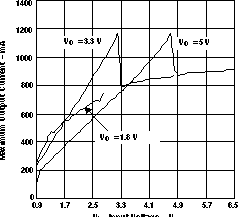
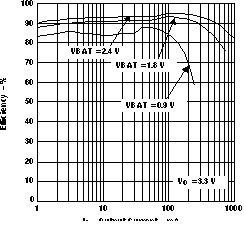
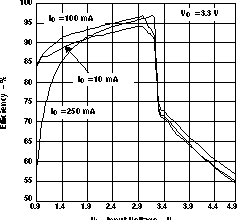
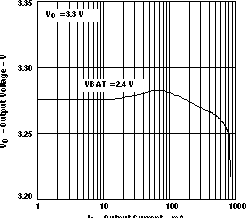
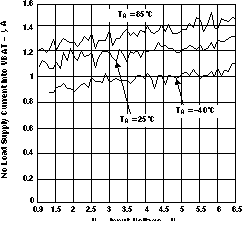
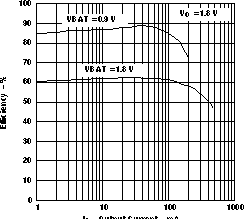
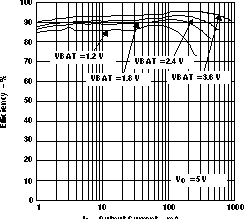
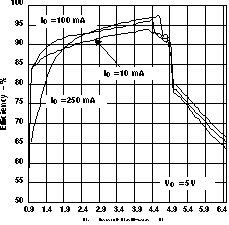
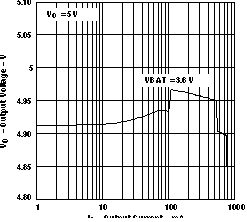
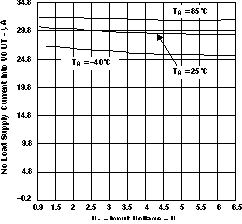
9 Parameter Measurement Information
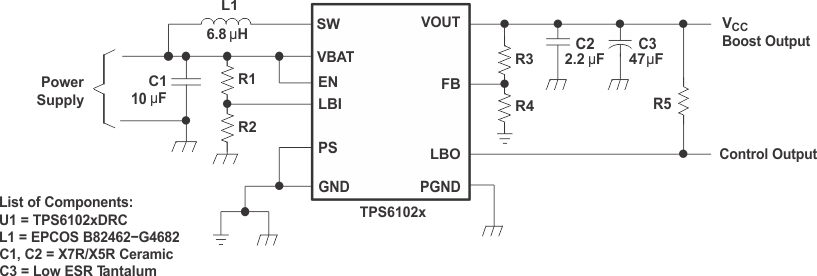 Figure 11. Parameter Measurement Schematic
Figure 11. Parameter Measurement Schematic